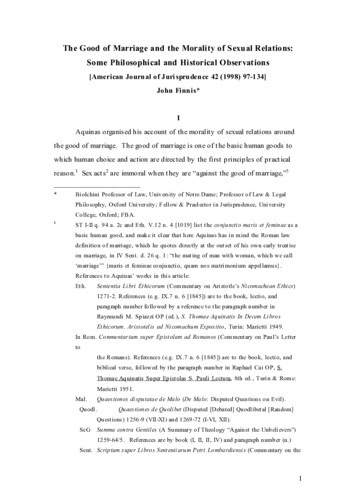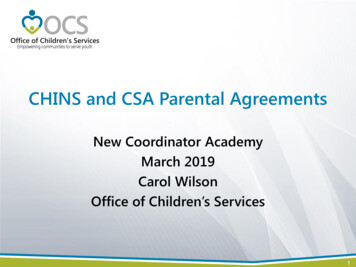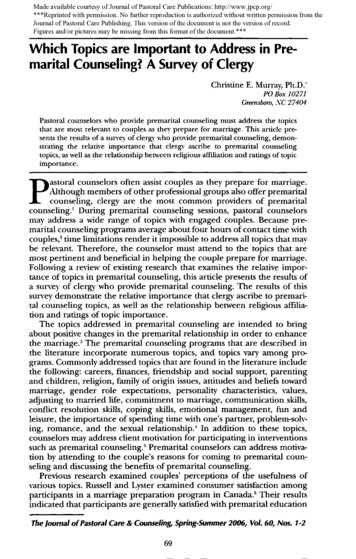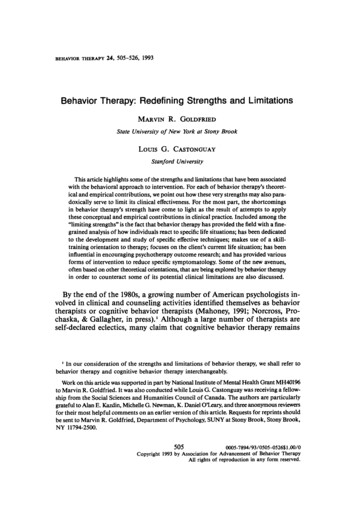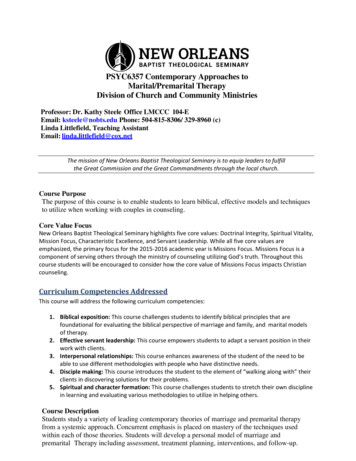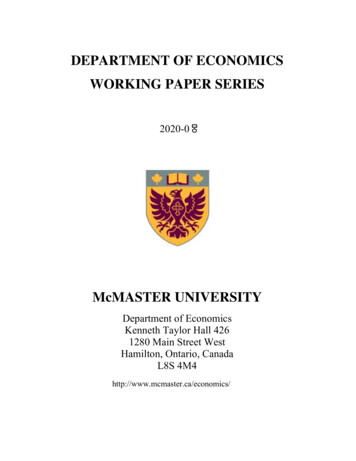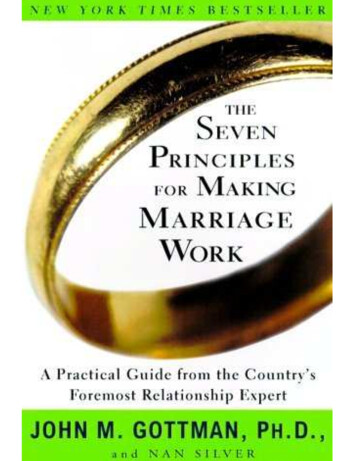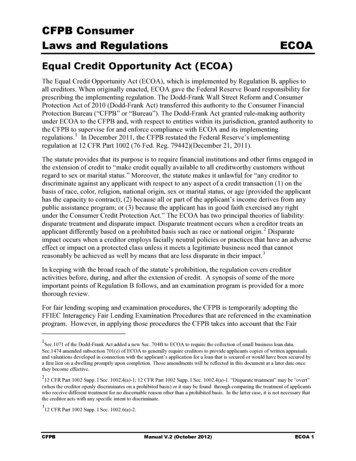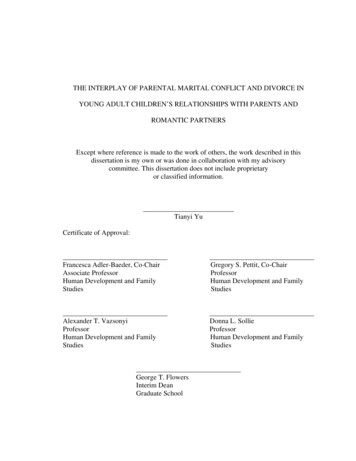
Transcription
THE INTERPLAY OF PARENTAL MARITAL CONFLICT AND DIVORCE INYOUNG ADULT CHILDREN’S RELATIONSHIPS WITH PARENTS ANDROMANTIC PARTNERSExcept where reference is made to the work of others, the work described in thisdissertation is my own or was done in collaboration with my advisorycommittee. This dissertation does not include proprietaryor classified information.Tianyi YuCertificate of Approval:Francesca Adler-Baeder, Co-ChairAssociate ProfessorHuman Development and FamilyStudiesGregory S. Pettit, Co-ChairProfessorHuman Development and FamilyStudiesAlexander T. VazsonyiProfessorHuman Development and FamilyStudiesDonna L. SollieProfessorHuman Development and FamilyStudiesGeorge T. FlowersInterim DeanGraduate School
THE INTERPLAY OF PARENTAL MARITAL CONFLICT AND DIVORCE INYOUNG ADULT CHILDREN’S RELATIONSHIPS WITH PARENTS ANDROMANTIC PARTNERSTianyi YuA DissertationSubmitted tothe Graduate Faculty ofAuburn Universityin Partial Fulfillment of theRequirements for theDegree ofDoctor of PhilosophyAuburn, AlabamaAugust 4, 2007
THE INTERPLAY OF PARENTAL MARITAL CONFLICT AND DIVORCE INYOUNG ADULT CHILDREN’S RELATIONSHIPS WITH PARENTS ANDROMANTIC PARTNERSTianyi YuPermission is granted to Auburn University to make copies of this dissertation at itsdiscretion, upon request of individuals or institutions and at their expense.The author reserves all publication rights.Signature of AuthorDate of Graduationiii
VITATianyi Yu, daughter of Kewen Yu and Zhilan Zhu, was born November 26, 1973,in Harbin, Heilongjiang Province, China. She graduated from No.14th High School ofHarbin in 1991. She attended Beijing University in Beijing, China, for five years andgraduated with a Bachelor of Arts degree in History in July 1996. She entered GraduateSchool at Auburn University, in August 2001, and obtained a Master of Science degree inHuman Development and Family Studies from Auburn University in May, 2004.iv
DISSERTATION ABSTRACTTHE INTERPLAY OF PARENTAL MARITAL CONFLICT AND DIVORCE INYOUNG ADULT CHILDREN’S RELATIONSHIPS WITH PARENTS ANDROMANTIC PARTNERSTianyi YuDoctor of Philosophy, August 4, 2007(M.S., Auburn University, 2004)(B.A., Beijing University, 1996)193 Typed PagesDirected by Gregory S. PettitA substantial body of literature has documented the effects of parental divorceand marital conflict on adult children’s interpersonal relationships with parents andromantic partners. However, few studies have tested the interaction between parents’marital conflict and divorce, and even fewer have considered interpersonal relationshipquality as outcomes. The present study builds on previous research by examining bothmain effect and interactive models of the relations between parental marital conflict,divorce, and young adults’ interpersonal relationships with mothers, fathers, and romanticpartners. This study also examines the role of child’s gender as a factor in the interplay ofparental marital conflict and divorce in adult children’s relationships with parents andromantic partners.v
Data were drawn from the Child Development Project, a prospective longitudinalstudy of a community sample of children and their families (N 585) who were initiallyrecruited the summer before the children’s entry into kindergarten, with follow-upassessments conducted annually through age 25. Parental marital conflict and parentaldivorce were measured from childhood through adolescence. The measures of motherchild and father-child relationships during the young adulthood included closenesssupport, conflict-control, and perceived filial self-efficacy. The measures of youngadults’ romantic relationships included relationship quality, relationship insecurity, andperceived relationship self-efficacy.Results indicate that both growing up with parents who had chronic conflict intheir marital relationships and experience of parental divorce were associated withmultiple problematic outcomes for young adult offspring’s relationships with parents andromantic partners. Divorce was also found to moderate the links between marital conflictand subsequent negativity in mother-adult child relationships, with the estimated effectsof marital conflict being more detrimental in the families in which parents remainmarried than in the families in which parents divorced later. This moderation effect wasstronger for females than for males. Results of the present study generally support theassumption that parental divorce may ameliorate some of the negative effects of maritalconflict on children’s adjustment by removing children from dysfunctional, conflictridden families. On the other hand, divorce still appears to be associated with lesscloseness and support between fathers and adult children and with lower quality andhigher insecurity in children’s romantic relationships, even beyond the effects of maritalconflict.vi
ACKNOWLEDGMENTSThe author would like to thank Dr. Gregory S. Pettit for his continuous guidance,patience, and mentoring throughout the course of this investigation. The author wouldalso like to thank Dr. Francesca Adler-Baeder for her support and direct advice, as wellas committee members Drs. Donna Sollie and Alexander Vazsonyi for their thoughtfulcommentary and generous guidance. Finally, special thanks are in order to Zhilan Zhu,my mom, for all of her unconditional support, guidance, encouragement, and love.vii
Style manual or journal used: Publication Manual of the American PsychologicalAssociation, Fifth EditionComputer software used: Microsoft Word 2003 for Windows, SPSS 14, AMOS 6.0.viii
TABLE OF CONTENTSLIST OF TABLES. xiiiLIST OF FIGURES .xv1. INTRODUCTION .12. LITERATURE REVIEW .13Theoretical Approaches .14Social learning theory .15Developmental perspective.16Stress (risk & resilience) perspective.18Marital Conflict and Divorce Effects on Parent-Adult Child Relationships .20Divorce.20Marital conflict.21The interplay of marital conflict and divorce .22Gender differences .24Summary .29Marital Conflict and Divorce Effects on Adult Children’s Romantic Relationships 30Divorce.30Marital conflict.33The interplay of marital conflict and divorce .34Gender differences .36ix
Summary .38Positive Effects of Parental Divorce .39Child’s Age at Divorce .43Purpose of Study .453. METHOD .48Participants.48Procedure .49Measures .51Divorce or separation.51Marital conflict.52Parent-adult child relationships.53Closeness-support .53Conflict-control.54Perceived filial self-efficacy .55Adult children’s romantic relationships.56Romantic relationship quality .57Romantic relationship insecurity .57Perceived relationship self-efficacy.58Control variables.60Treatment of Missing Data .60Plan of Analysis .614. RESULTS .66Preliminary Analysis.66x
Hypothesis 1.66Parent-child relationship outcomes.68Romantic relationship outcomes.72Research Question 1 .73Hypothesis 2.81Research Questions 2.1.89Research Questions 2.2.1005. DISCUSSION .110Are There Associations between Parental Marital Conflict and Divorce and YoungAult Children’s Relationships with Parents and Romantic Partners? .111Does Parental Marital Conflict and Divorce Have an Additive or Overlapping Effecton Young Adult Children’s Relationships with Parents and Romantic Partners? .114Are There Gender Differences in the Links of Parents’ Marital Conflict and Divorcewith Young Adult Children’s Relationships with Parents and Romantic Partners?117Does Divorce Moderate the Links of Marital Conflict with Young Adult Children’sRelationships with Parents and Romantic Partners? .119Are There Gender Differences in the Moderation Effect of Divorce on the Linksbetween Parents’ Marital Conflict and Young Adult Children’s Relationships withParents and Romantic Partners? .123Child’s Age at Time of Divorce .124Implications for Policy and Practices .126Limitation and Future Direction.128Conclusion and Contribution.131REFERENCES .133APPENDICES .155A: Additional Tables.156xi
B. IRB Approval Letter.167C. Measures in Child Development Project.169xii
LIST OF TABLESTable 1. Mean and Standard Deviation of Demographic Information for Participants.50Table 2. Mean (Standard Deviation) for Demographic, Parental Divorce, MaritalConflict, Mother-Child Relationship and Father-Child Relationship Variables byRomantic Relationship Status.62Table 3. Means, Standard Deviations, Skewness, Kurtosis, and Reliabilities for AllMeasures.67Table 4. Correlations among Parental Marital Conflict, Divorce, Parent-Adult ChildRelationships, and Adult Child Romantic Relationships .69Table 5.1. Standardized Coefficients Showing Associations between Parents’ MaritalConflict, Divorce (dichotomous), and Young Adult Children’s RelationshipOutcomes .74Table 5.2. Standardized Coefficients Showing Associations between Parents’ MaritalConflict, Divorce (dummies), and Young Adult Children’s RelationshipOutcomes .75Table 6. Multi-Group Nested Model Comparison by Divorce Status (dichotomous):Marital Conflict Predicting Relationship Outcomes .83Table 7.1. Multi-Group Nested Model Comparison by Gender: Divorce (dichotomous)and Marital Conflict Predicting Relationship Outcomes.90Table 7.2. Multi-Group Nested Model Comparison by Gender: Divorce (dummies) andMarital Conflict Predicting Relationship Outcomes .90Table 8.1. Standardized Coefficients Showing Associations between Parents’ MaritalConflict, Divorce (dichotomous), and Young Adult Children’s Relationshipswith Parents: Males vs. Females.92Table 8.2. Standardized Coefficients Showing Associations between Parents’ MaritalConflict, Divorce (dummies), and Young Adult Children’s Relationships withParents: Males vs. Females.93xiii
Table 9.1. Standardized Coefficients Showing Associations between Parents’ MaritalConflict, Divorce (dichotomous), and Young Adult Children’s Self-Efficacy:Males vs. Females.95Table 9.2. Standardized Coefficients Showing Associations between Parents’ MaritalConflict, Divorce (dummies), and Young Adult Children’s Self-Efficacy: Malesvs. Females .96Table 10.1. Standardized Coefficients Showing Associations between Parents’ MaritalConflict, Divorce (dichotomous), and Young Adult Children’s RomanticRelationships: Males vs. Females.98Table 10.2. Standardized Coefficients Showing Associations between Parents’ MaritalConflict, Divorce (dummies), and Young Adult Children’s RomanticRelationships: Males vs. Females.99Table 11. Multi-Group Nested Model Comparison by Gender and Divorce Status(dichotomous): Marital Conflict Predicting Relationship Outcomes .101Table 12. Standardized Coefficients Showing Associations between Parents’ MaritalConflict and Young Adult Children’s Relationships with Mothers: Non-DivorcedMales vs. Divorced Males vs. Non-Divorced Females vs. Divorced Females .103Table 13. Standardized Coefficients Showing Associations between Parents’ MaritalConflict and Young Adult Children’s Relationships with Fathers: Non-DivorcedMales vs. Divorced Males vs. Non-Divorced Females vs. Divorced Females .104Table 14. Standardized Coefficients Showing Associations between Parents’ MaritalConflict and Young Adult Children’s Filial Self-Efficacy: Non-Divorced Malesvs. Divorced Males vs. Non-Divorced Females vs. Divorced Females .106Table 15. Standardized Coefficients Showing Associations between Parents’ MaritalConflict and Young Adult Children’s Romantic Relationships: Non-DivorcedMales vs. Divorced Males vs. Non-Divorced Females vs. Divorced Females .107Table 16. Standardized Coefficients Showing Associations between Parents’ MaritalConflict and Young Adult Children’s Romantic Relationship Self-Efficacy: NonDivorced Males vs. Divorced Males vs. Non-Divorced Females vs. DivorcedFemales.109xiv
LIST OF FIGURESFigure 1. The Conceptual Model of the Study.63Figure 2. Standardized path coefficients of the multi-group structural equation model:Marital conflict predicting mother-child relationships (non-divorced vs.divorced groups) .84Figure 3. Standardized path coefficients of the multi-group structural equation model:Marital conflict predicting father-child relationships (non-divorced vs. divorcedgroups) .86Figure 4. Standardized path coefficients of the multi-group structural equation model:Marital conflict predicting filial self-efficacy (non-divorced vs. divorcedgroups) .86Figure 5. Standardized path coefficients of the multi-group structural equation model:Marital conflict predicting romantic relationship quality (non-divorced vs.divorced groups) .88Figure 6. Standardized path coefficients of the multi-group structural equation model:Marital conflict predicting relationship self-efficacy (non-divorced vs. divorcedgroups) .88xv
1. INTRODUCTIONDuring the last quarter of the 20th century, the composition of families, themarital status of adults, and the living arrangements of children in the United Statesunderwent remarkable changes (Fields & Casper, 2000). The proportion of the populationmade up of married couples with children decreased, while the proportion of singleparent families increased. A significant contributor to this phenomenon is the increase indivorce. Rates of divorce have more than tripled in the past 50 years, and the lifetimeprobability of a first marriage ending in divorce approaches 50% (Goldstein, 1999;Teachman, Tedrow, & Crowder, 2000). The trends in divorce have changed theexperience of family life in America for both children and young adults. About half of alldissolving marital unions consist of families with children (U.S. Bureau of the Census,1998). Forty percent of children will experience parental divorce in their growing years,with nearly 90% placed primarily in the physical custody of their biological mother(Amato, 2001). Parental divorce has been a central event in the growth process of asignificant number of American youth.Many studies have documented the short-term negative effects of parental divorcefor children. Most research finds that children of divorced parents are more likely, onaverage, to have behavioral and emotional problems than are children in two-biologicalparent families (for reviews see Amato, 2000, 2001; Grych & Fincham, 1999;1
Hetherington & Stanley-Hangan, 1999a; Kelly, 2000). Compared with children withnever-divorced parents, children of divorced parents are found to be at more risk of druguse, teen pregnancy, and engagement in antisocial behaviors. Parental divorce has alsobeen associated with lower academic achievement and higher school dropout rate forchildren.Looking beyond a child’s developing years, studies have also focused on thelong-term effects of parental divorce on young adult children’s adjustment. The earlyadult period represents a critical developmental period in the life course: success orfailures in the transition to independent living and in the establishment of intimaterelationships outside the family of origin may set the stage for social and emotionalfunctioning in the future (Doucet & Aseltine, 2003). Parent-adult child relationships stillplay a significant role during these critical years. Young adult children may receive manypotential benefits from parents, such as emotional support, companionship, advice witheducational plans, jobs, and family life, and financial help (Amato & Sobolewski, 2001).On the other hand, youth devote an increasing amount of time to interactions withpersons outside of the families, and these extra-familial relationships serve manyfunctions that were exclusive to familial relationships during childhood (Collins &Laursen, 2004). Specifically, close and romantic relationships have become primarysettings for youth to acquire interpersonal skills, such as problem-solving skills andcommunication skills (for reviews, see Collins, 2003). Therefore, establishing andmaintaining successful interpersonal relationships with parents and romantic partnersbecome one of the indicators of developmental success in this period.2
The experience of parental divorce during childhood has been found to beassociated with weak ties between parents and adult children. Compared with thosewhose parents remained continuously married, adult children with divorced parents hadbeen found to have less frequent contact with parents, show less affection for theirparents, and engage in fewer exchanges of assistance with parents (e.g., Amato & Booth,1991, 1996, 1997; Amato & Sobolewski, 2001; Aquilino, 1994; Cooney, 1994; Zill,Morrison, & Coiro, 1993). Parental divorce may also affect children’s experiences andbeliefs about close relationships, and may impact the romantic relationships of adultchildren. Children of divorced parents, as young adults, are generally found to haveearlier marriage, poorer marital relationships, and a greater likelihood of divorce(Franklin, Janoff-Bulman, & Roberts, 1990; Johnston & Thomas, 1996; Ross &Mirowsky, 1999). Hetherington (2003) also found that young adults from divorcedfamilies, compared to those from non-divorced families, were less likely to use effectiveproblem-solving strategies and showed more hostility in their interactions with romanticpartners.Divorce does not occur in isolation from other family processes, however. It isclear that interparental conflict is prevalent throughout separation and divorce (Thompson& Amato, 1999), and it can be viewed as an important stressor that typically accompaniesdivorce. Therefore, as children observe and experience the process of their parents’divorce, they also are likely to observe and experience dysfunctional family conflict. Thisraises an obvious research question about whether it is divorce per se, or the maritalconflict that goes hand in hand with divorce, that has stronger influences on children.3
As in the experience of divorce, exposure to chronic interparental conflict hasbeen found to be associated with a range of negative parent-child relationship attributesin later life (e.g., Amato & Afifi, 2006; Amato & Booth, 1997, 2001; Booth & Amato,1994; Riggio, 2004). These negative outcomes include lower levels of social support,greater emotional distance, and less overall contact. However, there are other researchfindings that indicate that parental divorce might be problematic for parent-childrelationships beyond the negative effects of interparental conflict (Riggio, 2004). First,divorce usually makes it difficult for noncustodial parents to maintain close relations withtheir children, resulting in disruption of a primary relationship for children as well aslosses in emotional and practical support (Lamb, 1999). Second, a variety of stressfulcircumstances following divorce can disrupt the quality of interactions between custodialparent and the child (Hetherington & Clingempeel, 1992). Booth and Amato (1994)found that both divorce and low parental marital quality had largely independent effectson later parent-child relationships. Specifically, marital unhappiness and instability werefound to weaken relationships between child and parents even those factors did not resultin divorce. However, if a divorce occurred, it was followed by a further deterioration inchild-parent relationships.Growing up with highly conflictual parents also appears to be a risk factor foroffspring’s later romantic relationships. Several cross-sectional studies have shown thatpeople who report high conflict in their parents’ marriages tend to report less happiness,more conflict, and more problems in their own marriages (Belsky & Isabella, 1985;Booth & Edwards, 1990; Overall, Henry, & Woodward 1974). Kirk (2002) found thathigh levels of perceived conflict in the childhood homes negatively affected young4
adults’ fears of intimacy and satisfaction in romantic relationships. Westervelt andVandenberg (1997) further found it was not the parental marital status, but conflictualparental relationships in the family that was significantly associated with less intimacy inromantic relationships for young adult children. These research findings indicate thatdivorce and conflict between parents are either independently or redundantly associatedwith adult children’s relationships with parents and romantic partners.A common question in current divorce research is whether it is better for parentswho are involved in conflictual, acrimonious, and unsatisfying marriages to stay togetherfor the well-being of their children or to divorce. The findings from the studies thatinvestigated both divorce and pre-divorce marital conflict indicate that the impact ofdivorce is not inevitably negative. Although divorce may usually be viewed as a stressfulevent in both an adult’s life and a child’s developmental processes, it may also present anew chance for adults to pursue more harmonious, fulfilling relationships, and a newopportunity for children’s personal growth, individuation, and well-being in a new familysituation (Hetherington & Stanley-Hagan, 1999b). Specifically, the Stress ReliefHypothesis (Wheaton, 1990) contends that a stressful life event, such as parental divorce,may actually have beneficial effects on children when it presents escape from a morestressful environment. Children of parents who engage in a long-term process of overt,unresolved conflict are at risk for a variety of developmental and emotional problems(Davies & Cummings, 1994; Emery, 1999). Under such a condition, when a divorceoccurs, these children are freed from a dysfunctional family environment and maygenuinely welcome the shift to a calmer single-parent family (Booth & Amato, 2001). Inother words, children who were living with high-conflictual parents may experience5
parental divorce as a stress relief event, which in turn, may lead to a post-divorceimprovement in child outcomes (Strohschein, 2005).Research findings from studies based on children’s reports have suggested thatchildren who perceived their parents’ marriage as high in conflict demonstrated betterlong-term adjustment if their parents divorced later than those whose parents did notdivorce (Amato, Loomis, & Booth, 1995; Hanson, 1999; Jekielek, 1998; Morrison &Coiro, 1999; Strohschein, 2005). When divorce is associated with a move to a moreharmonious, less stressful home environment with an authoritative parent, children indivorced families are similar in adjustment to children in low-conflict, non-divorcedfamilies and demonstrate better adjustment than children in high-conflict, non-divorcedfamilies (Amato et al., 1995; Hetherington, 1999). Conversely, children who viewed theirparents’ marriage as having low levels of conflict showed poorer long-term adjustment iftheir parents divorced than those whose parents did not divorce (Amato et al., 1995).They suggested that when parents exhibit a relatively low level of marital conflict,children might experience parental divorce as an unexpected, inexplicable, andunwelcome event. In these circumstances, divorce is likely to create a good deal of stressand instability in children’s lives (Amato, 2003).Most of the p
Conflict, Divorce (dummies), and Young Adult Children's Relationships with Parents: Males vs. Females.93 . xiv Table 9.1. Standardized Coefficients Showing Associations between Parents' Marital Conflict, Divorce (dichotomous), and Young Adult Children's Self-Efficacy: .

